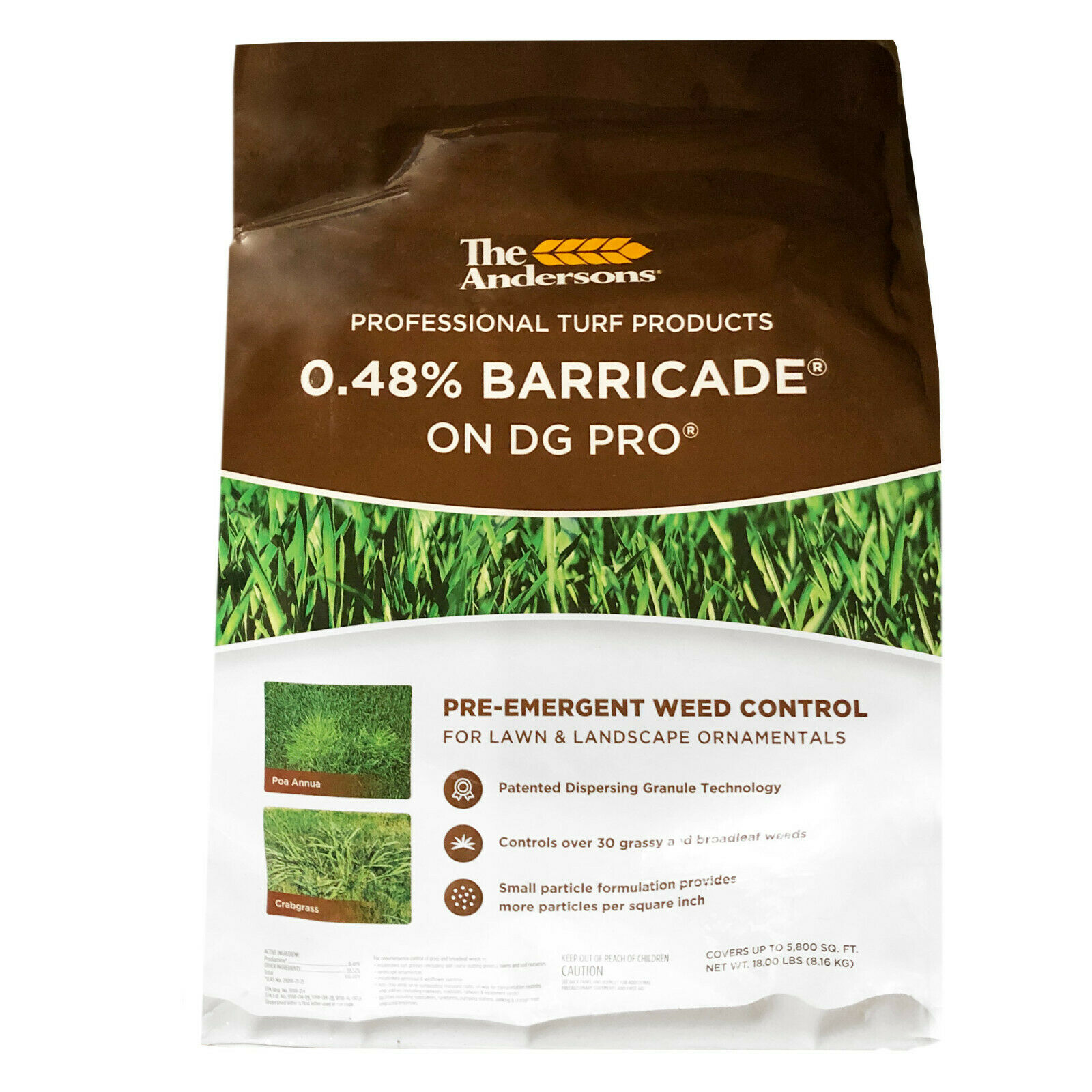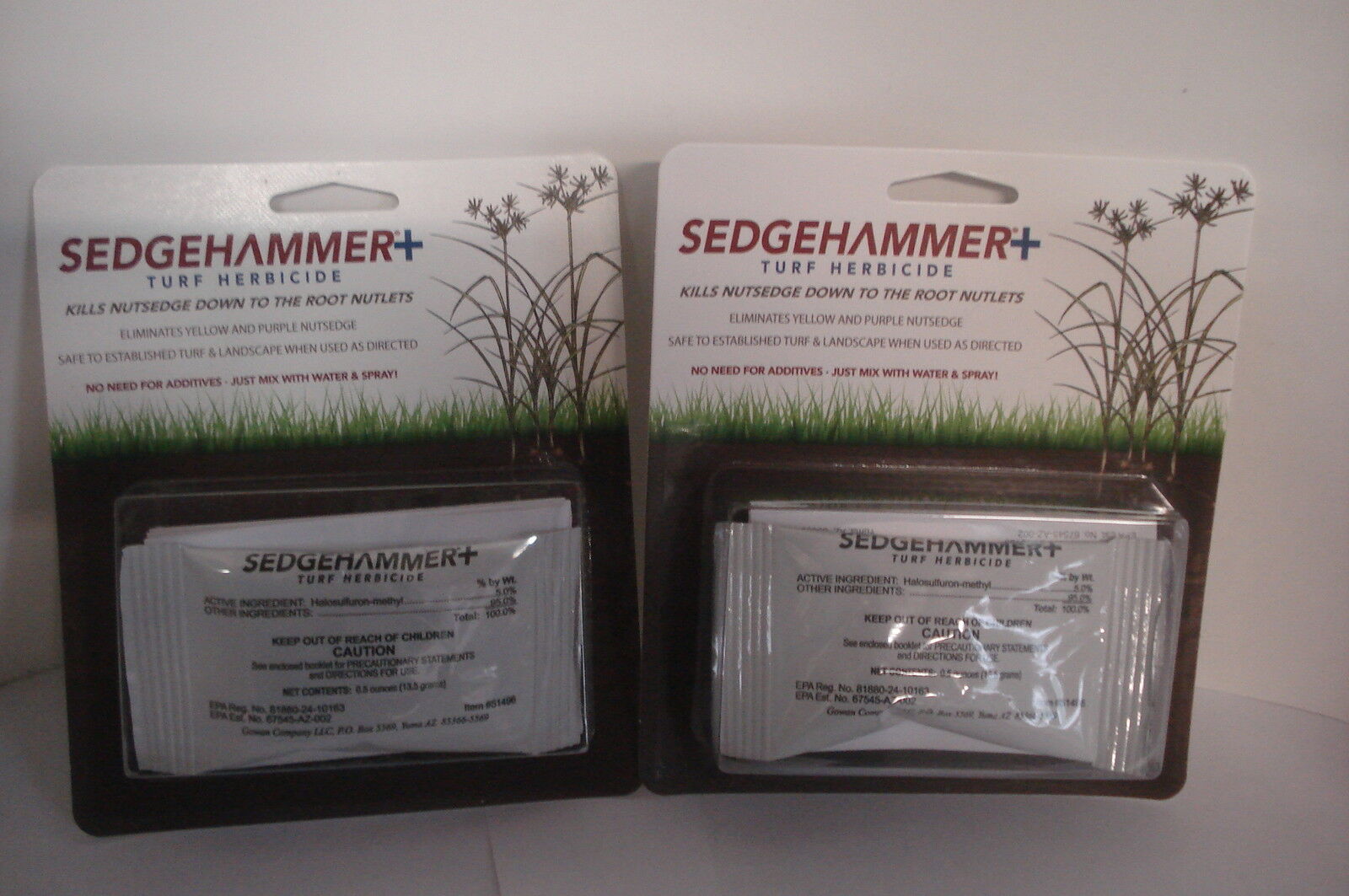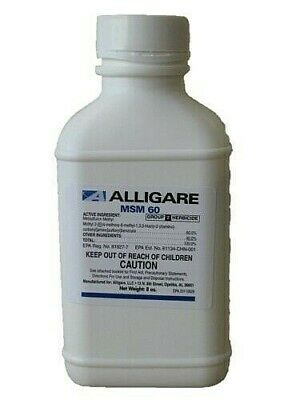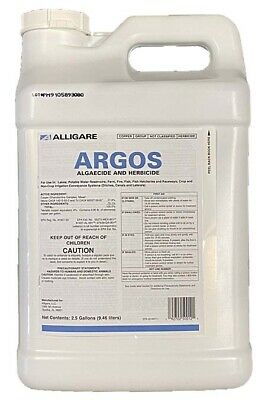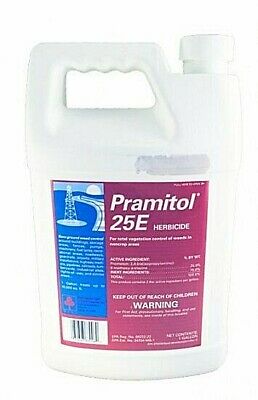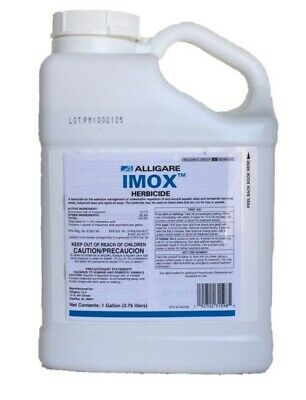-40%
Andersons .48 Barricade Pre-emergent Herbicide (18 Lb) Grassy + Broadleaf Weeds
$ 23.73
- Description
- Size Guide
Description
** Not For Sale To: ME, WYAndersons 0.48 Barricade Herbicide - 18 Lbs
Prodiamine - 0.48%
Prodiamine, the active ingredient in this pre-emergent herbicide, is proven to eliminate undesirable weeds without harming beneficial plants.
This Andersons 0.48% Barricade Herbicide prevents unwanted annual grassy and broadleaf weeds, including crabgrass, poa annua, goosegrass, and henbit.
This weed preventer provides excellent residual control of broadleaf weeds because it inhibits the seed germination and the root development of weeds.
Ideal to use in lawns, field-grown and landscape ornamentals, turfgrasses, sod farms, wildflower plantings, non-crop areas around managed rights-of-way for transportation systems like pumping stations, parking areas, tank farms, and Christmas tree farms.
To maximize weed control, Andersons 0.48% Barricade is best applied in the early spring and fall before weed seeds germinate. It is recommended to activate with at least 0.5-inch of water within 14 days after the application.
Targets:
Grassy and broadleaf weeds.
Read label for complete list.
Use:
Turf, lawns, sod farms, container, field-grown ornamentals, landscape ornamentals, conifer, and hardwood seedling nurseries, established perennial and wildflower plantings, non-crop areas on or surrounding.
Read label for complete list.
Application:
Apply evenly through suitable, calibrated application equipment. Apply in early spring prior to crabgrass emergence.
Read label for complete instructions.
Dispersing granule formula.
Details
For preemergence control of grass and broadleaf weeds in established turfgrasses (excluding golf course putting greens), lawns and sod farms; container and field grown ornamentals; landscape ornamentals; conifer and hardwood seedling nurseries; established perennial and wildflower plantings; non-crop areas on or surrounding managed rights-of-way for transportation systems and utilities (including roadways, roadsides, railways and equipment yards); facilities including substations, tank farms, pumping stations, parking and storage areas, ungrazed fencerows, and Christmas tree farms.
APPLICATION DIRECTIONS
Apply uniformly through suitable, calibrated application equipment.
ESTABLISHED TURF
Golf courses (except putting green), lawns, parks, athletic fields, and sod farms.
Apply this product in the early spring prior to crabgrass emergence. All applications must be made prior to germination of the target weeds. This product will not control established weeds.
Weeds Controlled
When used at the recommended rates this product will control:
Barnyard
Bluegrass, annual
Carpetweed
Chickweed, common
Chickweed, Mouseear (from seed)
Crabgrass
Crowfootgrass
Cupgrass, Woolly
Foxtails, annual
Goosegrass
Henbit
Itchgrass
Johnsongrass (from seed)
Junglerice
Knotweed
Kochia
Lambsquarter, common
Lovegrass
Oxalis
Panicum (Texas, fall, browntop)
Pigweed
Purslane, common
Pusley, Florida
Rescuegrass
Shepherd's Purse
Signalgrass, broadleaf
Speedwell, Persian
Sprangletop
Spurge, Prostrate
Witchgrass
Woodsorrel, yellow (from seed)
Rates of Application
Bermudagrass (established), Bahiagrass, Centipedegrass, Kikuyugrass, Seashore Paspalum, St. Augustinegrass, Tall Fescue (including turf-type), Zoysiagrass
May be applied over two applications
1.8-7.3 lbs/1000 sq. ft. (0.38-1.5 lbs. ai/A)
Buffalograss, Kentucky Bluegrass, Perennial Ryegrass
May be applied over two applications
1.8-4.8 lbs/1000 sq. ft. (0.38-1.0 lbs. ai/A)
Fine Fescue (including Red Fescue)
One application only
1.8-3.6 lbs/1000 sq. ft. (0.38-0.75 lbs. ai/A)
Creeping Bentgrass (0.5 inch and greater height)
One application only
1.8-2.4 lbs/1000 sq. ft. (0.38-0.5 lbs. ai/A)
In areas of high weed pressure or with extended growing seasons, a second application 60-90 days after the initial application may be made. Do not make a second application to Fine Fescue and Creeping Bentgrass. Do not make a second application if using the high rate on Buffalograss, Kentucky Bluegrass or Perennial Ryegrass.
Do not make more than 2 applications per year.
Do not apply more than 7.2 lbs/1000 sq. ft. per year.
Most effective weed control in turfgrasses will be obtained when this product is activated by at least 0.2 inch of rainfall or irrigation prior to weed seed germination and within 14 days following application.
When to Apply After Overseeding Turf
Do not apply to overseeded turf within 60 days after seeding or until after the second mowing. whichever is longer. Injury to desirable seedlings is likely if this product is applied before seedling secondary roots are in the second inch of soil, not thatch plus soil.
Use Precautions and Restrictions
The following precautions apply to the use of this product in turfgrasses and lawns:
Application of this product may thin emerged annual bluegrass and newly overseeded grasses.
Do not apply to overseeded turf within 60 days after seeding or until after the second mowing, whichever is longer.
Injury to desirable seedlings is likely if this product is applied before seedling secondary roots are in the second inch of soil, no thatch plus soil.
Do not cut (harvest) treated sod before 120 days after application. Do not apply to newly set sod until the following year.
Application of this product to turf stressed by drought, low fertility, or pest damage may result in turf injury.
Disturbing the herbicide barrier with cultural practices such as disking may result in reduced weed control.
Do not apply this product to putting greens or areas where dichondra, colonial bentgrass, velvet bentgrass, or annual bluegrass are desirable species.
Do not apply to golf course putting greens.
CONTAINER, FIELD GROWN, AND LANDSCAPE ORNAMENTALS
THIS PRODUCT MAY BE APPLIED FOR RESIDUAL PREEMERGENCE WEED CONTROL IN ORNAMENTALS (INCLUDING ESTABLISHED PERENNIAL AND WILDFLOWER PLANTINGS AND CHRISTMAS TREE FARMS).
Use Rates
Apply this product at 3.1 to 7.2 lbs./1000 sq. ft. (135 to 313 lbs./A) in fall and/or spring. Use higher rate of application for longer control periods. Sequential applications may be made so long as the total amount of product applied does not exceed the maximum annual application rate of 7.2 lb./1000 sq. ft. (313 lbs./acre).
Application Timing and Information
This product is a preemergence herbicide and will not control emerged weeds. Most effective weed control in ornamentals will be obtained when this product is activated by at least 0.5 inch of rainfall or irrigation or with shallow (1 to 2 inch) mechanical incorporation, prior to weed seed germination and within 14 days following application.
Best weed control is obtained when this product is applied to sol free of clods, weeds, and debris such as leaves and mulch. Prior to application of this product, control existing vegetation by hand weeding, cultivation or the use of an appropriate postemergence herbicide.
Apply this product to dry foliage only. Overhead irrigation or rainfall soon after application will wash granules off plant foliage and activate this product in the soil.
Established Container, Field Nursery Stock or Landscape Plants
Apply this product at any time to established container or field nursery stock. It may be applied as a broadcast or over the top application.
Newly Transplanted Container or Field Nursery Stock
This product may be applied to newly transplanted container or field nursery stock after the soil is allowed to settle and has been thoroughly watered. For cuttings, apply after the cuttings form roots and become established. Apply this product before budding/grafting or after the buds/grafts have taken. This is to avoid any inhibition of the tissue union.
Shadehouses and Uncovered Polyhouses
This product may be used in shade houses and uncovered poly houses, as well as outdoor locations. Keep the covered poly house open for at least 7 days and 2 irrigations that total a minimum of 0.5 inch of water after the application.
Bare Ground Applications for Container Placement
This product may be applied to the soil, mulch, gravel, wood chips or other permeable bases on which containerized ornamentals are located. After application, perform shallow cultivation or hand weeding only, minimizing exposure of untreated soil.
Tolerant Ornamental Species
This product will not harm most trees, shrubs, vines, and flowers. The species listed below are tolerant to this product. This product is approved for application to the species listed except in California. Best results will be obtained when this product is uniformly applied to the soil surface. This product may be applied over the top of these species.
When plants are under stress (such as heat, drought, or frost damage) some cultivars of listed plants may be sensitive to this product.
Tolerant Ornamentals - All States
Fir species
Japanese Maple
Norway Maple
Kiwi
Lily-of-the-Nile
Vine Hill Manzanita
Cape Weed
Japanese Aucuba
Barberry
Wintergreen Barberry
Mentor Barberry
Japanese Barberry
Weeping Bottlebrush
Scotch Heather
Hottentot Fig
Feathery Cassia
Wild Lilac
False Cypress
Cleyera
Citrus Species
Flowering Dogwood
American Dogwood
Pampas Grass
Cranberry Cotoneaster
Cotoneaster
Bearberry Cotoneaster
Rockspray Cotoneaster
Hawthorne
Italian Cypress
White Trailing Ice Plant
Hop Bush
Silverberry
Wintercreeper
Japanese Spindle Tree
Spreading Euonymus
Japanese Aralia
Border Forsythia
Greenstem Forsythia
Gardenia, Cape-Jasmine
Gladiolus species
English Ivy
Rose of Sharon
Chinese Hibiscus
Chinese Holly
Japanese Holly
American Holly
Holly
Yaupon Holly
Iris Species
Winter Jasmine
Chinese Juniper
Shore Juniper
Creeping Juniper
Walnut
Shrimp Plant
Crape Myrtle
Amur Privet
Japanese Privet
Glossy Privet
Big Blue Lilyturf
Japanese Honeysuckle
Tatarian Honeysuckle
Magnolia species
Ice Plant
Crabapple
Heavenly Bamboo
Narcissus species
Oleander
Olive
Mondo Grass
Trailing African Daisy
Sourwood
Avocado
Frasier's Photinia
Spruce Species
Lily-of-the-Valley Shrub
Calabrian Pine
Canary Island Pine
Slash Pine
Aleppo Pine
Austrian Black Pine
Longleaf Pine
Monterey Pine
Eastern White Pine
Scotch Pine
Loblolly Pine
Japanese Black Pine
Virginia Pine
Pistachio
Queensland Pittosporum
Japanese Pittosporum
Japanese Yew
English Laurel
Almond, apricot, nectarine, peach, plum, and prune
Douglas Fir
Firethorn Scarlet
Firethorn
Bradford Pear spp.
Oak species
Indian Hawkthorne
Coral bells, Formosa, Hino-crimson, PJM, Roseum-Elegans
lady bank's rose
rosemary
leatherleaf fern
stonecrop
Japanese Box cherry
Japanese yew
Yew
American Arborvitae
Star Jasmine
Canada Hemlock
Tulip Species
Japanese Viburnum
Sweet Viburnum
Japanese Snowball
Canary Island Viburnum
Laurustinus
Cranberry Bush
Leatherleaf Viburnum
Vinca
Dwarf Periwinkle
Grape
Old Fashioned Weigela
Spanish Bayonet
Yucca, Adam's Needle
Tolerant Ornamental Species/Varieties - All States Except California
Abelia: Sherwood
Yarrow: King Edward
Five-leaf or chocolate vine
lady's leek, nodding onion
Japanese anemone
Aquilegia: red and gold
Wormwood; silver mound; castle
aster: bonny blue, purple dome
lady fern; fern lady
fibrous begonia: hardy Grandis
snowbank
Bougainvillea
butterfly-bush; royal red
crimson bottlebrush
tussock bellflower
trumpet creeper, trumpet flower, madame Galen
coreopsis: Early Sunrise, Moonbeam
Lucifer
Cooperi Pink
Larkspur, Blue Elf
Dianthus, Maiden Pinks
Cheddar Pink
Coneflower, Purple, Magnus
Weeping Forsythia
Gaillardia, Blanket Flower: Goblin
Gentian
Cranesbill
baby's breath
sunrose
Daylily: Aztec gold, Stella de Oro, tender love
Coral Bell; Bridget Bloom
Mallow; Disco Belle White
Hosta, Plantain Lily Ragra rant
Hosta, 'Searsucker'
Bigleaf Hydrangea
Sword-leaved iris
siberian iris; cabernet
Parsoni
crape myrtle;Tuscaroraa
weeping lantana
lavender; Munstead
edelweiss
Chinese privet; variegata
Lily: Jazz
Lirope, variegated
lirope; creeping
Cardinal Flower, Indian Pink
Burgundy
Loosestrife; Modern Pink
Yaku Jima, Silberfeder
Evening Primrose
Osmanthus: Gulf Tide
Tree Peony
Fountain Grass
Dragonhead, False; Vivid
Oak, Shumard's Red
Yedda hawthorn
Black-eyed Susan: Goldstrum
stonecrop
SPirea: Anthony Waterer
Germander
Meadow Rue
Arrowood Viburnum
No oral advice or written information given by American Pest supplies shall create a warranty.
American Pest Supplies is a seller of various products. American Pest Supplies does not warranty the safety or the effectiveness of any of the products listed on this website. Any warranty or guarantee of safety or purpose for any particular use lies solely with the manufacturer.
Pest Control Products always have a label attached and it is here by noted that for all purposes the label is the law and according to federal law the product label must be followed and that any pesticide product must be used according to the label directions.
Any advice or recommendations given by American Pest supplies or anyone representing American Pest Supplies will never be intended to take the place of the pesticide label.The pesticide label is the law and a legal document. Always read and follow the label directions before using any pesticide product.
Some of the products sold by American Pest Supplies could require special licensing training or registration of the user in that users State, County, City, Etc. It is the sole responsibility of the purchaser and/or the end user to provide a license, permit, registration etc. If required by that purchasers local or state authorities.It is the sole responsibility of the user to verify that any products purchased are licensed for use in their State, County or City.
The customer assumes all responsibility for safe, proper and legal use of any products they purchase. The products we sell are intended for personal use only, in accordance with the customer's state laws and restrictions.
It is a violation of Federal law to use this product in a manner inconsistent with its labeling. The Label is The Law !
This product cannot be used for any purpose that it is not labeled for!
